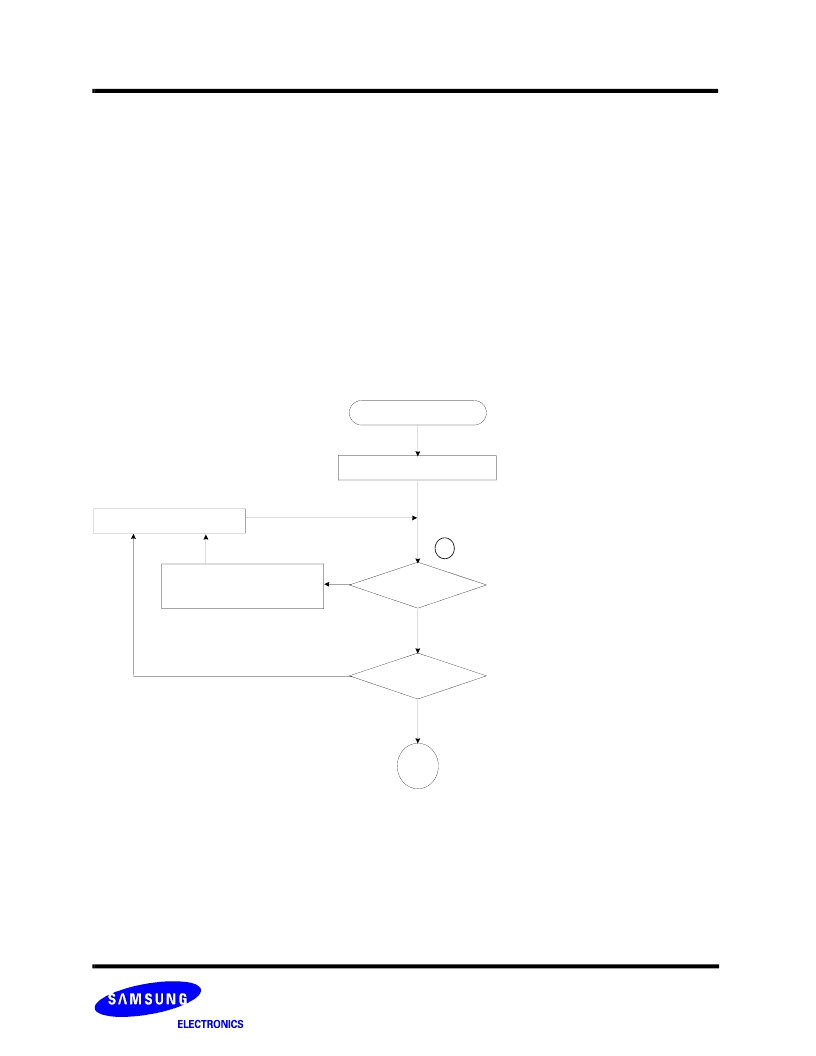- 您現(xiàn)在的位置:買賣IC網(wǎng) > PDF目錄373088 > K9K4G08U1M (SAMSUNG SEMICONDUCTOR CO. LTD.) 256M x 8 Bit / 128M x 16 Bit / 512M x 8 Bit NAND Flash Memory PDF資料下載
參數(shù)資料
| 型號: | K9K4G08U1M |
| 廠商: | SAMSUNG SEMICONDUCTOR CO. LTD. |
| 英文描述: | 256M x 8 Bit / 128M x 16 Bit / 512M x 8 Bit NAND Flash Memory |
| 中文描述: | 256M × 8位/ 128M的× 16位/ 512M × 8位NAND閃存 |
| 文件頁數(shù): | 14/40頁 |
| 文件大?。?/td> | 839K |
| 代理商: | K9K4G08U1M |
第1頁第2頁第3頁第4頁第5頁第6頁第7頁第8頁第9頁第10頁第11頁第12頁第13頁當前第14頁第15頁第16頁第17頁第18頁第19頁第20頁第21頁第22頁第23頁第24頁第25頁第26頁第27頁第28頁第29頁第30頁第31頁第32頁第33頁第34頁第35頁第36頁第37頁第38頁第39頁第40頁

FLASH MEMORY
14
Preliminary
K9F2G08U0M K9F2G16U0M
K9K4G08U1M
NAND Flash Technical Notes
Identifying Initial Invalid Block(s)
All device locations are erased(FFh for X8, FFFFh for X16) except locations where the initial invalid block(s) information is written
prior to shipping. The invalid block(s) status is defined by the 1st byte(X8 device) or 1st word(X16 device) in the spare area. Sam-
sung makes sure that either the 1st or 2nd page of every initial invalid block has non-FFh(X8) or non-FFFFh(X16) data at the column
address of 2048(X8 device) or 1024(X16 device). Since the initial invalid block information is also erasable in most cases, it is
impossible to recover the information once it has been erased. Therefore, the system must be able to recognize the initial invalid
block(s) based on the original initial invalid block information and create the initial invalid block table via the following suggested flow
chart(Figure 3). Any intentional erasure of the original initial invalid block information is prohibited.
Initial Invalid Block(s)
Initial invalid blocks are defined as blocks that contain one or more invalid bits whose reliability is not guaranteed by Samsung. The
information regarding the initial invalid block(s) is so called as the invalid block information. Devices with initial invalid block(s) have
the same quality level as devices with all valid blocks and have the same AC and DC characteristics. An initial invalid block(s) does
not affect the performance of valid block(s) because it is isolated from the bit line and the common source line by a select transistor.
The system design must be able to mask out the initial invalid block(s) via address mapping. The 1st block, which is placed on 00h
block address, is guaranteed to be a valid block, does not require Error Correction up to 1K program/erase cycles.
*
Check "FFh( or FFFFh)" at the column address
2048(X8 device) or 1024(X16 device)
Figure 3. Flow chart to create initial invalid block table.
Start
Set Block Address = 0
Check "FFh
or FFFFh"
Increment Block Address
Last Block
End
No
Yes
Yes
Create (or update)
Initial Invalid Block(s) Table
No
of the 1st and 2nd page in the block
相關PDF資料 |
PDF描述 |
|---|---|
| K9S1208V0M-SSB0 | 64M x 8 Bit SmartMedia Card |
| K9S1208V0 | 64MB & 128MB SmartMediaTM Card |
| K9D1G08V0M | 64MB & 128MB SmartMediaTM Card |
| K9S6408V0A-SSB0 | 8M x 8 Bit SmartMediaTM Card |
| KA-3020 | 3x2mm SINGLE COLOR SURFACE MOUNT LED LAMPS |
相關代理商/技術參數(shù) |
參數(shù)描述 |
|---|---|
| K9K4G16Q0M | 制造商:SAMSUNG 制造商全稱:Samsung semiconductor 功能描述:512M x 8 Bit / 256M x 16 Bit NAND Flash Memory |
| K9K4G16U0M | 制造商:SAMSUNG 制造商全稱:Samsung semiconductor 功能描述:512M x 8 Bit / 256M x 16 Bit NAND Flash Memory |
| K9K8G08U0A | 制造商:SAMSUNG 制造商全稱:Samsung semiconductor 功能描述:1G x 8 Bit / 2G x 8 Bit / 4G x 8 Bit NAND Flash Memory |
| K9K8G08U0A-P | 制造商:SAMSUNG 制造商全稱:Samsung semiconductor 功能描述:1G x 8 Bit / 2G x 8 Bit NAND Flash Memory |
| K9K8G08U0A-PCB0T00 | 制造商:Samsung SDI 功能描述: |
發(fā)布緊急采購,3分鐘左右您將得到回復。